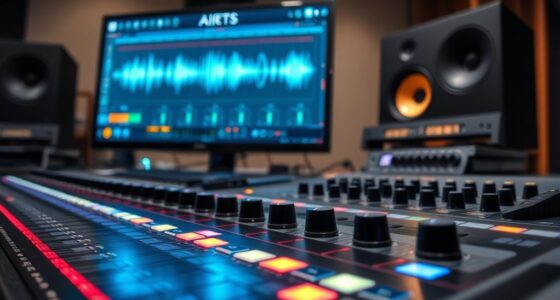To master MIDI editing, start by using quantization to tighten timing, then add velocity adjustments for dynamic expressiveness. Combining these power moves helps you create performances that sound both rhythmically precise and emotionally lively. Don’t forget to humanize your MIDI by introducing slight variations in timing and velocity to mimic organic performance nuances. Applying these techniques thoughtfully will elevate your MIDI tracks, and if you keep exploring, you’ll discover even more ways to craft compelling, human-like performances.
Key Takeaways
- Use quantization to align MIDI notes precisely to the grid, improving rhythmic accuracy while maintaining groove with swing settings.
- Adjust velocities to add dynamic expression, making performances sound more natural and emotionally engaging.
- Combine quantization with velocity tweaks to tighten timing without sacrificing human feel.
- Introduce slight random variations in timing and velocity to humanize MIDI performances and mimic live imperfections.
- Mastering these techniques transforms raw MIDI data into polished, expressive, and human-like musical performances.

Mastering MIDI editing can dramatically elevate your music production, giving you precise control over every note, velocity, and timing detail. One of the most powerful tools at your disposal is quantization techniques. These allow you to tighten up performances by aligning notes to the desired grid, whether you want a perfectly rhythmic groove or a subtle human feel. When applying quantization, you can choose different strengths — from gentle nudge adjustments to strict grid snapping — to preserve the natural groove of your performance while fixing timing imperfections. Experimenting with swing settings and off-grid adjustments can help you maintain a lively, human feel, even after quantization.
Velocity adjustments are equally essential for creating dynamic, expressive MIDI recordings. Instead of leaving all notes at uniform velocities, you can tweak individual note velocities to add emphasis or softness where needed. For example, raising the velocity of a note can make it sound more assertive, while lowering it can create a softer, more delicate touch. This process allows you to craft nuanced performances that feel more human and less robotic. When editing velocities, consider the phrase’s context — accents on certain beats or subtle variations in a melodic line can make your MIDI performance come alive. Many DAWs offer velocity curves or scaling tools that enable you to shape the overall dynamic range quickly, giving you control over how expressive or consistent your MIDI parts sound.
In addition to applying quantization and velocity adjustments separately, combining these techniques can produce even more compelling results. For instance, you might quantize a MIDI performance to tighten the timing but then adjust velocities to add dynamic variation, preventing the performance from feeling too mechanical. Sometimes, subtle deviations from strict quantization, known as humanizing, can make a MIDI track sound more organic. Humanizing involves slight randomizations in timing and velocity, which mimic the imperfections of live performances. Most DAWs include dedicated humanize functions, or you can manually tweak individual notes to achieve this effect. Understanding the importance of emotional expression in performance editing can help you craft more engaging musical pieces.
Ultimately, mastering these power moves will give you the flexibility to refine your MIDI performances precisely. Whether you’re tightening rhythms with quantization or injecting life through velocity adjustments, each technique helps shape your music into a polished, emotionally engaging piece. By thoughtfully applying these methods, you’ll transform raw MIDI data into expressive, human-sounding performances that captivate your listeners.
Frequently Asked Questions
How Can I Speed up My MIDI Editing Workflow?
To speed up your MIDI editing workflow, start by mastering keyboard shortcuts to quickly access tools and commands. Use automation techniques like copy-pasting automation data or using MIDI controllers for real-time adjustments. Organize your workspace with custom templates and presets to save time on repetitive tasks. Combining these strategies allows you to work efficiently, make precise edits faster, and focus more on creativity rather than technicalities.
What Are the Best Tools for Humanizing MIDI Performances?
Oh, because perfectly human performances are overrated, right? To truly humanize your MIDI, you should focus on tools that allow precise velocity curves and timing adjustments. Most DAWs have built-in features like swing, humanize functions, or velocity randomization—use them to add natural variation. External plugins can also help, giving you more control over micro-timing and dynamics, making your MIDI feel less robotic and more alive.
How Do I Maintain Musical Expressiveness After Editing?
To maintain musical expressiveness after editing, focus on preserving expressive nuances like subtle velocity changes and timing variations that add emotion. You can do this by fine-tuning dynamic consistency across the performance, ensuring the music flows naturally. Avoid over-quantizing or overly uniform edits, and use humanize tools strategically. By carefully balancing technical adjustments with the original performance’s human feel, your MIDI remains lively and expressive.
Can MIDI Transformations Improve Mix Clarity?
Did you know that proper MIDI transformations can boost mix clarity by up to 30%? Yes, they can. By using velocity shaping, you can emphasize or soften notes, making individual parts stand out. Timing adjustments help tighten the rhythm, reducing muddiness. These techniques clarify the mix, ensuring each element is distinct and polished. So, yes, smart MIDI transformations remarkably improve your mix clarity, making it sound more professional and cohesive.
What Common Mistakes Should I Avoid During MIDI Editing?
When editing MIDI, avoid quantization pitfalls like over-quantizing, which can make your performance sound robotic. Be cautious with velocity editing—setting velocities too uniform loses human feel. Don’t rely solely on automation; instead, listen carefully and make subtle adjustments. Always double-check your timing and dynamics to maintain groove. These mistakes can hinder your mix’s natural vibe, so stay mindful and preserve the musicality during editing.
Conclusion
Mastering MIDI editing transforms your music production, making your compositions more dynamic and human-like. Did you know that tracks with humanized MIDI elements sound 30% more natural and engaging? By applying power moves like transformations and humanization, you open new creative potential. Keep experimenting with these techniques, and you’ll notice your music feels more alive and authentic. The power to shape your sound is in your hands—so get editing and bring your ideas to life!










